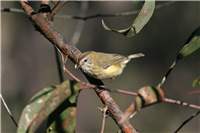Family
Pardalotidae
Genus
Acanthiza
Species
lineata
Threats/Control Methods - Regional
This species is at risk of loosing important eucalypt forest and woodland habitat due the increasing pressure from weed infestations, logging for urban development, grazing and agriculture.
Threats/Control Methods - Local
Young thornbills at the nest are at risk of predation by domestic Cats (Felis catus) or from being pushed out of their nest by a young Fan-tailed Cuckoo (Cacomantis flabelliformis ).
Local/Urban Actions
Gardens should be kept free from weeds, as they are easily transported from homes into nearby native forest areas. If possible, more mature gardens should not be replaced with smaller trimmed trees in overly neat yards, as Striated Thornbills prefer thick, mature vegetation with high branches.
Common Names
Striated Thornbill, Striated Tit, Striped Tit, Striped-crowned Tit
Distinguishing Features
The Striated Thornbill is a small 10cm bird with olive green to brown plumage. It has a light coloured face, throat and chest with heavy black streaks and a red-brown crown with fine white streaks. Young birds are similar, with less streaking on the underparts.
Survey Techniques
Call and visual identification.
Species Call
A soft, insect-like 'tzzt-tzztit, tzzit'.
Similar Species
This species is similarly sized and shaped to the Brown Thornbill (Acanthiza pu silla) however, the Striated Thornbill has distictive white streaks on the crown and dark streaks on the chest. Its call is also distict and of a higher pitch.
Distribution
It is found only in the southeastern corner of Australia's mainland, from southern QLD to southern SA.
Country of Origin
Australia
Conservation (Pet/Pest) Status - Regional
This species is probably the most common of the small birds in the forests just outside Canberra and visits the suburbs regularly. Breeding records however, appear to be declining (COG).
Conservation (Pet/Pest) Status - National
Secure, not listed under the EPBC Act 1999.
LSCCES Population
Highest numbers were found at the ANBG, followed by BMt, CSIRO, ANU and BMP.
Associated vegetation community
Striated Thornbills usually prefer high-rainfall and thick eucalypt forest; however they are also found in drier, more open woodland areas. Within urban parklands, they prefer more mature vegetation of at least 10 years in age.
Limiting Resources
This species requires good water sources and thick vegetation, preferring to feed in the highest, thickest parts of tall eucalypt trees. They are also more easily found in areas with complex vegetation layers, including shrubs, logs and groundcover.
Breeding
Striated Thornbills build a neat, rounded nest of grass and bark bound with spider web and hung from branches from 1-20m off the ground. The breeding season runs from early September to early January. The female incubates the three eggs for around 17 days and both parents care for the young in the nest for 20 days after hatching.
Behaviour
This species is harder to spot than most other small birds, as it prefers to move constantly in the very thick tops of tall eucalypt trees. It is not migratory, although population numbers vary, dipping to lowest levels in spring.
Functional Group
This species is mostly an Insectivore, but does eat nectar and seeds occasionally.
Food Species
Striated Thornbills forage for insects in large flocks, often mixing with other insect-eating birds. They will eat most insects, but are known for eating psyllids and reducing insect infestations.
Predators
The height at which this species flies and feeds makes it less susceptible to predation than many other small birds.
Interesting Fact
Fan-tailed Cuckoos (Cacomantis flabelliformis ) are known to enjoy the Striated Thornbill's nest, laying their eggs there and leaving their young to benefit from the free food and foster parenting.
References - (reader suitability of references, P=Primary teachers, S=Secondary students, T=Tertiary students and researchers)
Books:Freudenberger, D. 2001. Bush for the birds: Biodiversity enhancement guidelines for the Saltshaker Project, Boorowa, NSW. Consultancy report to Greening Australia ACT and SE NSW Inc. CSIRO Sustainable Ecosystems. Canberra. S, T
Morcombe, M. 2000. Field Guide to Australian Birds. Steve Parish Publishing. Archerfield. Australia P, S, T
Schodde, R. and Tideman, S. (eds) 1990. Reader's Digest Complete Book of Australian Birds (2nd Edition). Reader's Digest Services Pty Ltd. Sydney. P, S, T
Veerman, P. 2003. Canberra Birds: A report on the first 21 years of the garden bird survey. Philip Veerman and Canberra Ornithologists Group. Canberra. S, T
Internet: Birds in Backyards 2006. [online]. Available at:http://www.birdsinbackyards.net P, S, T
Canberra Ornithological Group (COG). 2004. Birds of Canberra Gardens. COG and the ACT Department of Urban Services. [online]. Available athttp://garden.canberrabirds.org.au/ P, S, T
Online Publications:Nix, H. and Cunningham, R. 2006. Birds of the Lower Sullivans Creek Catchment, Canberra ACT. Prepared for the Life in the Suburbs project using data from the Lower Sullivans Creek Catchment Ecological Survey (LSCCES). Australian National University. Canberra. [online]. Available at: http://www.lifeinthesuburbs.com.au/category.php?id=65 S, T
Taws, N. et al. 2001. Bringing Birds Back: A Glovebox Guide for Bird Identification and Habitat Restoration in ACT and SE NSW. Greening Australia ACT and SE NSW Inc. [online]. Available at: http://www.greeningaustralia.org.au/NR/rdonlyres/D8B0DB48-7B51-419D-9C93-A48FB26E8CD3/3888/G12446BBBreprint1.pdf P, S, T

 Top
Top Top
Top